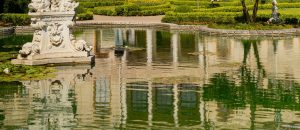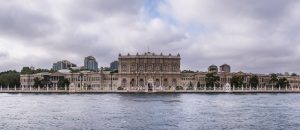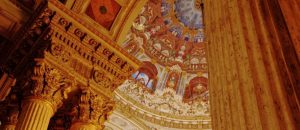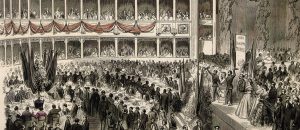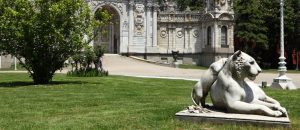Dolmabahçe Palace is not only an architectural achievement but also a monument to the massive logistical and economic power of the 19th-century Ottoman Empire, capable of mobilizing resources from all corners of the realm. Every marble block, every precious stone, and every wooden beam used in the construction of the palace tells the story of a challenging journey from different geographies of the empire to the capital. The procurement process for these materials proves that the construction of Dolmabahçe was not just a building project, but also a demonstration of power spreading through all the veins of the empire.
Marmara Island: The Marble that Gave the Palace its White Skin
The main material for the dazzling white and striking facade of Dolmabahçe Palace, reflected in the Bosphorus, is the famous Marmara marble extracted from Marmara Island (ancient name Prokonnesos). This marble, used in imperial structures from Hagia Sophia to Süleymaniye for thousands of years, faced its greatest demand with the construction of Dolmabahçe. Special quarries were opened on the island, hundreds of workers were employed, and massive marble blocks weighing tons were cut and transported to Istanbul by ship.
This operation was not just a mining activity. Extracting the marble blocks from the quarries, lowering them to the shore, loading them onto barges, and delivering them to the construction site in Istanbul required incredible engineering and organizational skill given the technology of that era. The state issued special edicts for this operation, effectively mobilizing all resources on Marmara Island for the palace construction. In this respect, the palace facade is proof of how effectively the empire could command even its most fundamental and nearest resources. [Link: A source on the history and importance of Marmara marble -> https://www.mta.gov.tr/v3.0/sayfalar/bilgi-merkezi/madencilik/mermer-tr.pdf]
Egypt and Beyond: The Exotic Richness of the Interiors
While the exterior of the palace was clad in Marmara marble, a local and national resource, its interiors were adorned with exotic and valuable materials brought from the farthest corners of the empire and the world. This was a conscious choice to demonstrate the empire’s reach, extending not only to its immediate surroundings but also to its most distant territories and international markets.
Egyptian Water Marble (Alabaster): The walls of the Hünkâr Hamam (Sultan’s Bath), one of the most valuable spaces in the palace, and some other important rooms, were covered with translucent and veined water marble (alabaster/kaymaktaşı) brought from Egypt. The choice of this material was not accidental. Egypt was historically a symbol of wealth and ancient civilization, and at that time, it was one of the most crucial provinces of the empire. Using this stone in the capital’s palace carried a political message underlining dominance over Egypt.
Italian and Spanish Colored Marbles: Colored marbles such as red (Rosso Levanto) and green (Verde Antico), used in the palace floorings and some wall coverings, were generally imported from Mediterranean countries like Italy and Spain. This demonstrated the Ottoman Empire’s position within international trade networks and its financial ability to purchase European luxury materials.
Priceless Porphyry Stone: The red porphyry stone (Somaki), used in the most prestigious venues like the Süfera Hall (Ambassadors’ Hall), was considered the ultimate symbol of imperial power and wealth since ancient Rome. The procurement and use of this stone, which is very hard and difficult to process, is one of the clearest indicators that no expense was spared for the palace.
Wood and Stones from the Heart of Anatolia
Not only the visible facade of the palace but also its structural skeleton was built with materials sourced from different regions of the empire. The thick wooden beams and posts supporting the palace’s massive roof and internal partitions were typically sourced from the rich forests of the Black Sea region or the mountains of Bulgaria. The cutting of this timber, transporting it down rivers to the ports, and bringing it to Istanbul by ship was a major logistical operation in itself. Similarly, coarser stones used in the foundations and interior walls were brought from quarries in different parts of Anatolia.
A Logistical Show of Force
The construction of Dolmabahçe is like a symphony of materials, and the Sultan is the conductor of this symphony. The ability to import alabaster from Egypt, white marble from Marmara, colored marble from Europe, and timber from the Black Sea—the capacity to unite all these disparate resources, supply chains, and manpower towards a single goal at a construction site in Istanbul—is a demonstration of power as significant as a military victory. This proves how extensive the empire’s network of command was, not only politically and militarily but also economically, commercially, and logistically. [Link: The cost and economic background of the Palace -> /rakamlarla-dolmabahce-bir-sarayin-maliyeti-ve-bir-imparatorlugun-butcesi]
Conclusion
In conclusion, the imperial journey of the materials used to build Dolmabahçe Palace is as impressive as the structure itself. The palace is not merely an aesthetic object but a three-dimensional reflection of the empire’s geographic and economic map. From the white marble of Marmara to the alabaster of Egypt, from the colored marbles of Europe to the timber of Anatolia, every single piece offers invaluable information about the Ottoman Empire’s 19th-century resource management, logistical capacity, and global reach.









